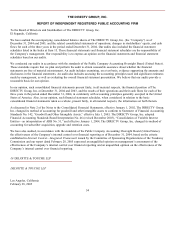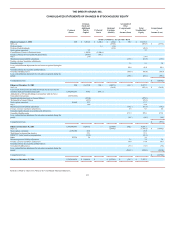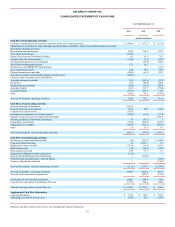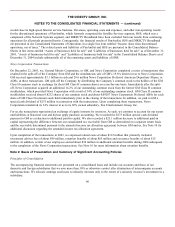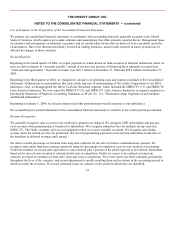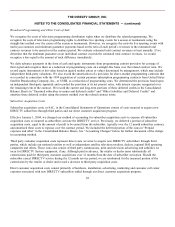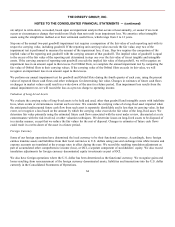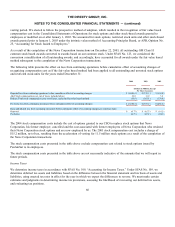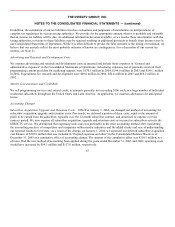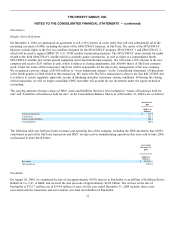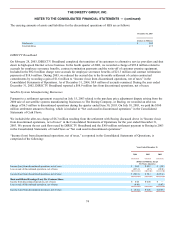DIRECTV 2004 Annual Report Download - page 73
Download and view the complete annual report
Please find page 73 of the 2004 DIRECTV annual report below. You can navigate through the pages in the report by either clicking on the pages listed below, or by using the keyword search tool below to find specific information within the annual report.
THE DIRECTV GROUP, INC.
NOTES TO THE CONSOLIDATED FINANCIAL STATEMENTS — (continued)
are subject to write-down, as needed, based upon an impairment analysis that occurs at least annually, or sooner if an event
occurs or circumstances change that would more likely than not result in an impairment loss. We amortize other intangible
assets using the straight-line method over their estimated useful lives, which range from 2 to 12 years.
Step one of the annual two-part goodwill impairment test requires a comparison of the fair value of each reporting unit with its
respective carrying value, including goodwill. If the reporting unit carrying value exceeds the fair value, step two of the
impairment test is performed to measure the amount of the impairment loss, if any. Step two requires the comparison of the
implied value of the reporting unit goodwill with the carrying amount of that goodwill. The implied value of goodwill is equal
to the excess of the fair value of the reporting unit determined in step one over the fair value of its net tangible and intangible
assets. If the carrying amount of reporting unit goodwill exceeds the implied fair value of that goodwill, we will recognize an
impairment loss in an amount equal to that excess. For Orbital Slots, we complete the annual impairment test by comparing the
fair value of Orbital Slots to their carrying values. If the carrying value of the Orbital Slots exceeds its fair value, we will
recognize an impairment loss in an amount equal to that excess.
We perform our annual impairment test for goodwill and Orbital Slots during the fourth quarter of each year, using the present
value of expected future cash flows and other techniques for determining fair value. Changes in estimates of future cash flows
or changes in market values could result in a write-down of the asset in a future period. If an impairment loss results from the
annual impairment test, we will record the loss as a pre-tax charge to operating income.
Valuation of Long-Lived Assets
We evaluate the carrying value of long-lived assets to be held and used, other than goodwill and intangible assets with indefinite
lives, when events or circumstances warrant such a review. We consider the carrying value of a long-lived asset impaired when
the anticipated undiscounted future cash flow from such asset is separately identifiable and is less than its carrying value. In that
event, we recognize a loss based on the amount by which the carrying value exceeds the fair value of the long-lived asset. We
determine fair value primarily using the estimated future cash flows associated with the asset under review, discounted at a rate
commensurate with the risk involved, or other valuation techniques. We determine losses on long-lived assets to be disposed of
in a similar manner, except that we reduce the fair values for the cost of disposal. Changes in estimates of future cash flows
could result in a write-down of the asset in a future period.
Foreign Currency
Some of our foreign operations have determined the local currency to be their functional currency. Accordingly, these foreign
entities translate assets and liabilities from their local currencies to U.S. dollars using year-end exchange rates while income and
expense accounts are translated at the average rates in effect during the year. We record the resulting translation adjustment as
part of accumulated other comprehensive income (loss), or OCI, a separate component of stockholders’ equity. We also record
translation adjustments for foreign currency denominated equity investments as part of OCI.
We also have foreign operations where the U.S. dollar has been determined as the functional currency. We recognize gains and
losses resulting from remeasurement of the foreign currency denominated assets, liabilities and transactions into the U.S. dollar
currently in the Consolidated Statements of Operations.
64


